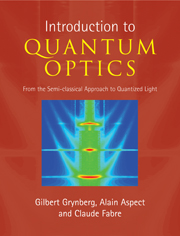Book contents
- Frontmatter
- Contents
- Foreword
- Preface
- Acknowledgements
- Part I Semi-classical description of matterlight interaction
- 1 The evolution of interacting quantum systems
- Complement 1A: A continuum of variable width
- Complement 1B: Transition induced by a random broadband perturbation
- 2 The semi-classical approach: atoms interacting with a classical electromagnetic field
- Complement 2A: Classical model of the atom-field interaction: the Lorentz model
- Complement 2B: Selection rules for electric dipole transitions. Applications to resonance fluorescence and optical pumping
- Complement 2C: The density matrix and the optical Bloch equations
- Complement 2D: Manipulation of atomic coherences
- Complement 2E: The photoelectric effect
- 3 Principles of lasers
- Complement 3A: The resonant Fabry–Perot cavity
- Complement 3B: The transverse modes of a laser: Gaussian beams
- Complement 3C: Laser light and incoherent light: energy density and number of photons per mode
- Complement 3D: The spectral width of a laser: the Schawlow–Townes limit
- Complement 3E: The laser as energy source
- Complement 3F: The laser as source of coherent light
- Complement 3G: Nonlinear spectroscopy
- Part II Quantum description of light and its interaction with matter
- Part III Applying both approaches
- Index
Complement 3G: Nonlinear spectroscopy
Published online by Cambridge University Press: 05 August 2012
- Frontmatter
- Contents
- Foreword
- Preface
- Acknowledgements
- Part I Semi-classical description of matterlight interaction
- 1 The evolution of interacting quantum systems
- Complement 1A: A continuum of variable width
- Complement 1B: Transition induced by a random broadband perturbation
- 2 The semi-classical approach: atoms interacting with a classical electromagnetic field
- Complement 2A: Classical model of the atom-field interaction: the Lorentz model
- Complement 2B: Selection rules for electric dipole transitions. Applications to resonance fluorescence and optical pumping
- Complement 2C: The density matrix and the optical Bloch equations
- Complement 2D: Manipulation of atomic coherences
- Complement 2E: The photoelectric effect
- 3 Principles of lasers
- Complement 3A: The resonant Fabry–Perot cavity
- Complement 3B: The transverse modes of a laser: Gaussian beams
- Complement 3C: Laser light and incoherent light: energy density and number of photons per mode
- Complement 3D: The spectral width of a laser: the Schawlow–Townes limit
- Complement 3E: The laser as energy source
- Complement 3F: The laser as source of coherent light
- Complement 3G: Nonlinear spectroscopy
- Part II Quantum description of light and its interaction with matter
- Part III Applying both approaches
- Index
Summary
The advent of lasers has revolutionized the methods and possibilities of spectroscopy. Their monochromaticity permits the study of extremely narrow spectral features which would not have been resolved using classical techniques. Moreover, their extreme spectral power density, in giving rise to the field of nonlinear optics, which will be studied in Chapter 7, has resulted in the development of new and powerful spectroscopic techniques. These techniques, of which we describe briefly some examples in this complement, have as their basis the fact that an atom does not respond linearly when subjected to a very intense light field.
First of all we shall describe the broadening mechanisms that explain the fact that the experimentally measured widths of atomic or molecular resonances are larger than those that would be observed if the atoms were isolated and at rest. We shall introduce in Section 3G.1 the concept of homogeneous width, which can be considered as the intrinsic width of a transition, and inhomogeneous width which concerns the variation of the frequency of a given transition that occurs because of the state of motion of the atom, or because of factors in its environment. We shall explain why it is possible, using nonlinear optical techniques to eliminate the effects of inhomogeneous broadening on recorded spectra, resulting in an improvement over the resolution of conventional techniques. We shall then concentrate more specifically on Doppler broadening, which is the most commonly encountered source of inhomogeneous broadening, describing two nonlinear optical techniques, saturated absorption spectroscopy (in Section 3G.2) and two-photon spectroscopy (in Section 3G.3), which enable it to be overcome.
- Type
- Chapter
- Information
- Introduction to Quantum OpticsFrom the Semi-classical Approach to Quantized Light, pp. 283 - 298Publisher: Cambridge University PressPrint publication year: 2010



